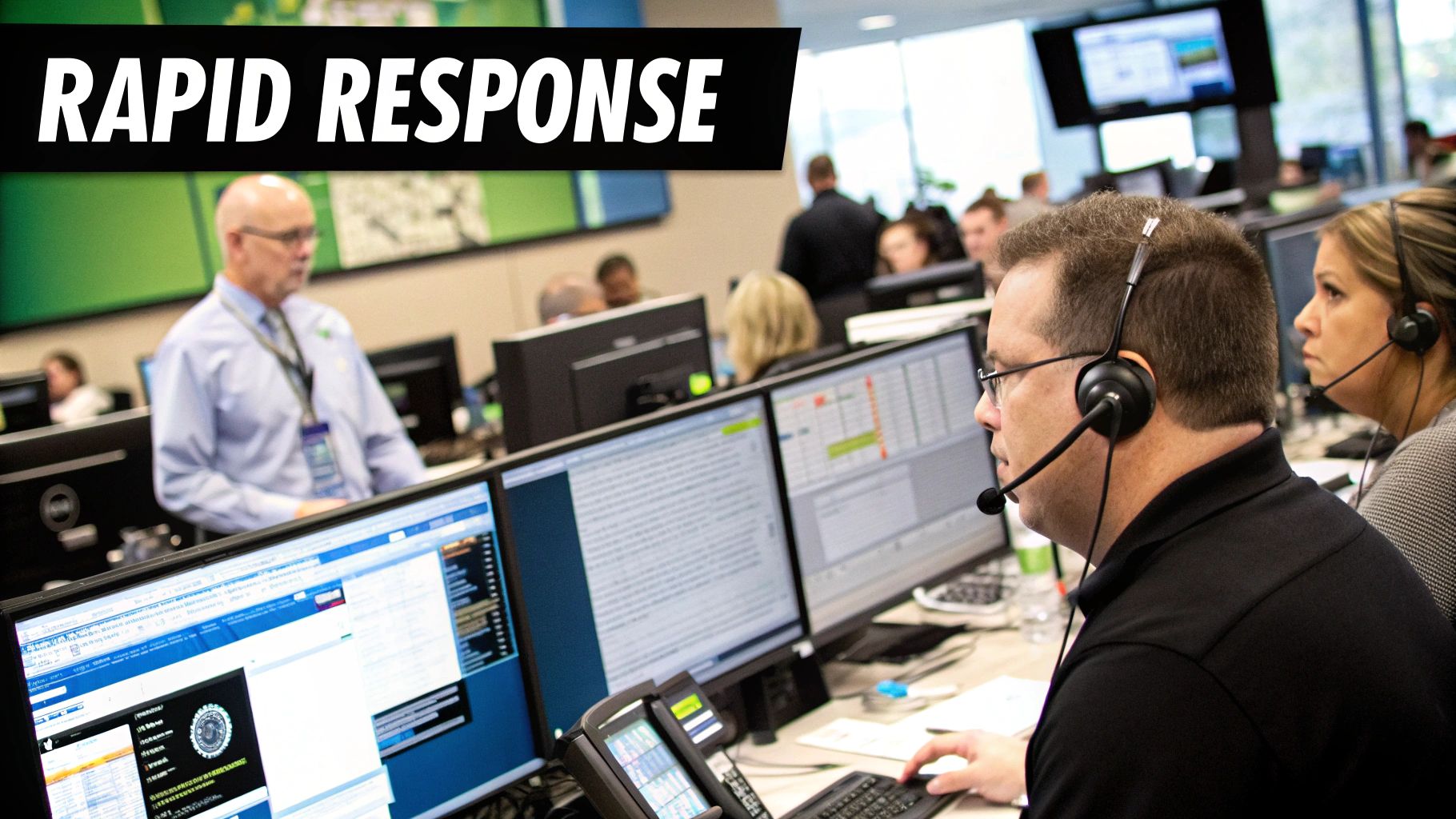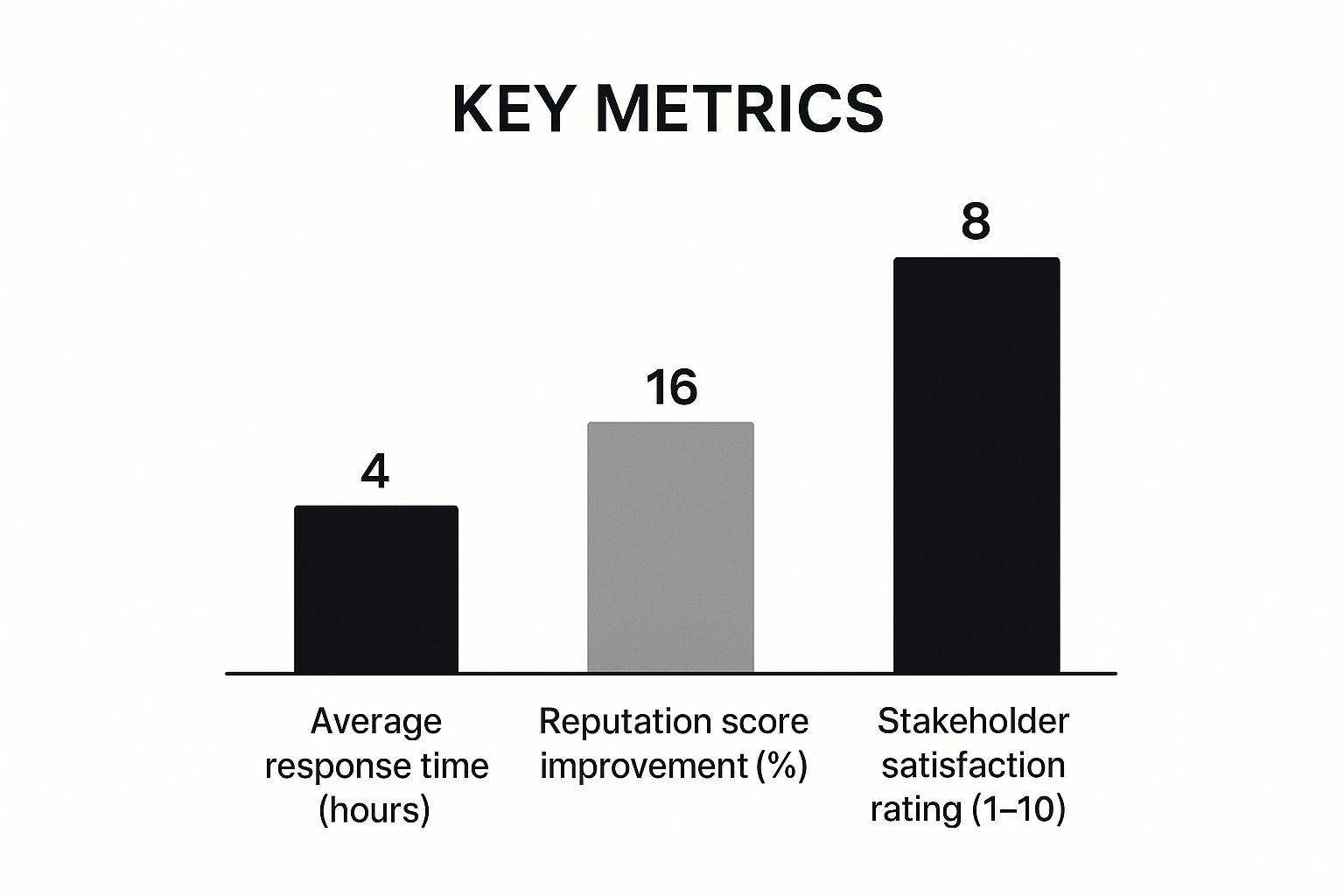
Public Relations Crisis Management That Actually Works
How UK Crisis Management Has Actually Changed

The UK public relations landscape has dramatically changed. The old reactive approach to crisis management simply won't cut it anymore. Proactive planning and strategic preparation are now essential for successfully navigating PR crises. This shift reflects a fundamental change in how crises play out in our interconnected world.
The constant flow of information online, fueled by the 24/7 news cycle and the immediacy of social media, demands quick thinking. There's little time to react. Organizations must be prepared to act swiftly and decisively to minimize any damage.
This new reality affects the entire UK PR sector. The UK’s PR sector, with over 6,967 businesses as of 2025, is increasingly focused on strategic crisis management. These businesses face mounting pressure to anticipate potential problems and have robust plans in place. This shift is a direct response to the faster news cycle and the instant spread of information online. Reactive measures are no longer sufficient. Learn more about the changing face of PR crisis management here. Regulatory pressures, like GDPR compliance, also influence how British crisis protocols are developed and implemented.
Adapting to the New Normal in Crisis Communications
This shift has major implications for organizations of all sizes. Those clinging to outdated, reactive approaches are putting themselves at risk. This vulnerability goes beyond reputational damage. It includes potential financial losses and legal issues. Organizations that have embraced proactive crisis planning, however, are experiencing the rewards. They're better prepared to handle challenging situations, protect their reputations, and even emerge stronger after a crisis.
The Importance of Preparation and Training
This new era of crisis management requires a fresh approach to training and preparation. Traditional crisis simulations and tabletop exercises aren’t enough anymore. Organizations need dynamic training programs that mirror the speed and complexity of modern crises. This means more than just rehearsing prepared statements. It involves empowering staff to make informed, on-the-spot decisions under pressure. This also includes a deep understanding of the unique challenges posed by the UK media landscape.
Building Crisis Readiness That Actually Functions
The uncomfortable truth is that many organizations aren't truly prepared for a crisis. They might have plans and conduct drills, but true crisis readiness goes beyond checking boxes. It's about building practical systems that function under pressure, delivering results when they matter most.
Assembling a Responsive Crisis Management Team
Building a strong crisis management team is crucial. It’s about selecting individuals with the right skills and temperament to perform under pressure, much like assembling a specialized fire brigade. Each member needs specific training and the ability to work together seamlessly in high-stakes situations. This means clearly defined responsibilities, robust communication protocols, and a culture of swift, collaborative decision-making.
Crafting Communication Plans That Work Under Stress
Your communication plans need to be dynamic and adaptable, like a pilot’s pre-flight checklist. They should offer clear, concise guidance that can be easily accessed and followed, even in the chaos of a crisis. This includes designated spokespeople, pre-approved messaging, and defined channels for internal and external communication.
Conducting Effective Crisis Training Exercises
Effective training strengthens crisis readiness. While many organizations conduct exercises, they often fail to replicate the pressure of a real crisis. The 2025 BCI Emergency & Crisis Communications Report highlights a growing trend: UK organizations are increasingly investing in preparedness training. In 2024, 75% of surveyed organizations conducted crisis training at least once, while over 80% exercised their crisis plans with similar frequency. This reflects a heightened awareness of the importance of readiness. Explore the report in more detail here. Effective training goes beyond basic simulations; it requires scenarios that challenge assumptions, expose weaknesses, and push teams beyond their comfort zones.
Why Comprehensive Preparation Is Non-Negotiable
In our interconnected world, crises can escalate quickly, impacting reputation, operations, and the bottom line. Comprehensive public relations crisis management, particularly in the digital age, is essential. Building true crisis readiness involves investing in robust systems, effective team training, and resilient communication plans that can withstand intense scrutiny. This investment not only safeguards your organization during a crisis, but also cultivates resilience and strengthens your ability to navigate future challenges.
Why Your Crisis Plans Keep Failing (And How To Fix It)

Investing in crisis management technology is essential. However, technology alone isn't a silver bullet. The often-overlooked human element presents the biggest hurdles. Think of it like a sophisticated fire alarm system: useless if no one reacts to the alarm.
Similarly, the most advanced public relations crisis management plan will fall short if your team isn't equipped to execute it effectively.
The Human Factor: The Weakest Link
Despite investing in technology and training, human error remains a persistent challenge. Outdated contact information can prevent critical messages from reaching the right individuals. Poor internal coordination can lead to mixed messages and a confused public.
Most importantly, a lack of responsiveness can stall crisis management efforts. These human-centric obstacles often cause communication breakdowns during emergencies. We must confront these vulnerabilities head-on. For deeper insights, explore the human impact on crisis management here. Also, check out this valuable resource on mastering crisis management: How to master crisis management.
Building a Responsive Team
How do we strengthen these human-centric weaknesses? Start with your contact database. Ensure it’s always up-to-date. Regularly update details and verify accuracy.
Cultivate a culture of preparedness through regular training and drills that simulate real crises. This develops the crucial muscle memory for swift, effective responses. This includes clearly defined roles within the crisis management team and strong communication protocols.
Effective Communication Under Pressure
Develop clear and concise communication protocols. This ensures consistent messaging across all platforms. It empowers spokespeople to confidently address the media and the public.
Consider pre-approved messaging for common crisis scenarios. This saves valuable time during the critical initial stages of an incident. This proactive preparation can prevent a controlled response from escalating into a reputational disaster.
By addressing these human factors, you significantly improve the effectiveness of your crisis plan. Remember, technology is only as effective as the people using it. A well-prepared team is the foundation of effective public relations crisis management.
Communication Strategies That Save Your Reputation

When crisis strikes, your communication strategy can make or break your reputation. It becomes the very foundation of your public relations crisis management. Think of it as the rudder guiding your ship through stormy seas. This is especially relevant in the UK, where public attention is sharp and the media landscape pulls no punches.
Transparency and Speed: The Pillars of Effective Communication
Effective crisis communication rests on two vital elements: transparency and speed. Being open and honest with your stakeholders, even when delivering difficult news, cultivates trust. It’s like a soothing balm on a raw wound. Quick communication stops rumors and misinformation from spreading. The quicker you respond, the more command you have over the situation.
For example, data from recent UK crises and industry surveys highlight the crucial impact of effective communication. During the 2024 UK rail strikes, poor communication between unions, operators, and the public fueled widespread anger and significant financial losses. These events emphasize the necessity of communicating transparently, quickly, and accurately with everyone involved. Find more detailed statistics here. This proves just how vital clear communication is in lessening the blow of a crisis.
Tailoring Messages for Different Audiences
Different stakeholders need different communication styles. Your message to employees will differ from what you tell customers or the media. Think of explaining a complex medical diagnosis: you'd use simpler terms with a patient than with a colleague. Similarly, adapting your message ensures it connects with each specific audience, fostering understanding and calming anxieties.
Maintaining Consistency Across Channels
No matter the audience, your core message needs to be consistent across every channel. This prevents confusion and strengthens your credibility. Imagine a well-rehearsed orchestra: all instruments playing together create a unified, powerful performance. Consistent messaging achieves a similar impact, providing clarity and inspiring confidence in your response.
Learning From Success: Real-World Examples
Many UK organizations have successfully weathered crises through well-planned communication. Examining their methods offers valuable insights. These examples show how clear, consistent communication not only repairs trust, but can actually bolster a company’s reputation. For additional insights, read also: How to get press coverage. Studying these success stories can help you develop a winning communication plan for your own organization. This means identifying the specific communication decisions that aided recovery and applying these lessons to your own crisis management strategy.
Crisis Management Technology That Delivers Results
Over 60% of UK organizations are now using emergency notification systems and crisis platforms to bolster their responses. But in a world saturated with solutions, which tools truly make a difference? The key isn't chasing the latest gadget, but investing wisely in technology that strengthens your crisis response capabilities.
Choosing the Right Tools for Your Organization
Different technologies cater to different needs. Real-time alert systems, like Everbridge, provide instant notifications to key personnel when a crisis hits. Cloud-based management platforms, such as Noggin, offer centralized hubs for coordinating responses and tracking progress. Data-driven risk anticipation tools use analytics to identify potential threats before they escalate, like Resolver. Choosing the right technology depends on your organization's specific needs, size, and budget – matching the tool to the task at hand.
Integrating Technology With Human-Led Processes
Technology empowers, but it doesn't replace human expertise. The most advanced software can't replicate sound judgment or human empathy. It’s a powerful tool, but only truly effective when wielded by skilled hands. Technology should seamlessly integrate with human-led processes, supporting teams to respond effectively while retaining human oversight.
Real-World Implementations and Honest Assessments
Evaluating technology requires a candid assessment of its real-world impact. The infographic below visualizes data from organizations using crisis management technology, showcasing improvements in average response time, reputation score, and stakeholder satisfaction.

The data clearly demonstrates the positive impact of effective crisis management technology. Reduced response times, improved reputation scores, and boosted stakeholder satisfaction highlight the importance of informed technology investments. Further insights into reputation management can be found here: How to master your reputation management.
Practical Considerations: Timelines and Cost-Benefit Analysis
Implementing new technology requires careful planning. Realistic timelines and thorough cost-benefit analyses are crucial. Factor in the time needed for staff training and system integration. Weigh the costs against the potential benefits of improved response times and minimized reputational damage. This strategic approach ensures your technology investments align with your overall crisis management strategy and deliver long-term value.
To further aid in your decision-making process, the table below provides a comparison of essential crisis management tools.
The following table, "Essential Crisis Management Technology Stack," offers a comparison of key technology tools for crisis management, their primary functions, and implementation considerations specifically for UK organizations. This overview aims to provide a starting point for evaluating which technologies best align with your organizational needs.
| Technology Type | Primary Function | Implementation Timeline | Cost Consideration |
|---|---|---|---|
| Emergency Notification System (e.g., Everbridge) | Mass communication and alerting | 1-3 months | Subscription-based, varies by features and user count |
| Crisis Management Platform (e.g., Noggin) | Centralized hub for planning, response, and recovery | 3-6 months | Subscription-based, dependent on scale and complexity |
| Risk Intelligence Software (e.g., Resolver) | Threat monitoring, risk assessment, and predictive analytics | 6-12 months | Typically higher investment, often customized solutions |
| Social Listening Tools (e.g., Brandwatch) | Real-time monitoring of online conversations and sentiment | 1-2 months | Subscription-based, varies by platform and data access |
By considering these factors, UK organizations can make informed decisions about their crisis management technology stack, ensuring a resilient and effective response to any challenge.
Turning Crisis Into Competitive Advantage
A well-handled crisis can be so much more than just damage control. It can actually become a launchpad for positive and lasting change. Forward-thinking UK organizations recognize the aftermath of a crisis as a prime opportunity to rebuild, not just as they were, but stronger and more resilient, bolstering their competitive advantage. This isn't about putting a positive spin on a negative situation. It's about genuine learning, growth, and improvement.
Debriefing for Future Preparedness
Effective crisis debriefs are essential. Think of them as a post-game analysis for your crisis response. These debriefs provide incredibly valuable insights into what worked well, what fell short, and where improvements can be made. The goal isn't to assign blame, but to objectively identify any weaknesses in your systems and processes. For instance, how accessible and easy to implement was your crisis communication plan? Did your team perform effectively under pressure? Honest reflection is the cornerstone of building resilience for the future.
Implementing Lessons Learned
Identifying areas for improvement is just the first step. The true value lies in actively implementing those lessons. This might involve updating your contact database, refining your communication protocols, or even investing in new technology. It's like reinforcing the foundations of your house after a storm. Each adjustment, no matter how small, makes you stronger and better prepared for the next challenge.
Communicating Recovery Progress
Communicating effectively after a crisis is every bit as important as during the crisis itself. Keeping stakeholders informed about your recovery progress rebuilds trust and demonstrates accountability. This is particularly important in the UK, where transparency and accountability are highly valued. Regular updates, clear explanations of the corrective actions you're taking, and sincere expressions of responsibility all contribute to restoring confidence.
Building Organizational Resilience
Successfully navigating a crisis significantly strengthens an organization's resilience. It's like developing immunity after recovering from an illness. This hard-earned experience provides valuable knowledge and insights that will help you anticipate and mitigate future challenges. Organizations that embrace the learning opportunity presented by crises become more adaptable, agile, and better equipped to handle future difficulties.
Maintaining Momentum After Crisis Resolution
The period immediately after a crisis can be a critical window of opportunity. Maintaining momentum is essential for converting a difficult experience into a long-term competitive advantage. This might involve implementing new strategies, strengthening key stakeholder relationships, or reinforcing internal communication. By capitalizing on the lessons learned, organizations can transform a crisis into a catalyst for positive change and emerge stronger and more successful than before.
Your Crisis Management Implementation Roadmap
Building a robust public relations crisis management plan takes more than just theoretical knowledge. It requires a practical, step-by-step approach designed for the unique challenges and regulatory environment of the UK. This roadmap offers actionable frameworks for putting your planning into action, complete with realistic timelines and ways to measure your success.
Phase 1: Assessment and Planning (1-2 Months)
This initial phase focuses on understanding where your organization is vulnerable and defining clear objectives. Just as a surveyor examines a building's foundation, this stage is critical for building a strong crisis management strategy.
-
Key Activities: Conduct a comprehensive risk assessment, identify your key stakeholders, define crisis communication protocols, and create a first draft of your crisis management plan.
-
Success Metrics: A finished risk assessment report, a documented stakeholder map, and a drafted crisis communication plan.
Phase 2: Development and Training (2-3 Months)
Now it’s time to develop and refine your crisis management plan and train your team to use it effectively. Think of it like a fire drill – preparing your team to respond quickly and efficiently under pressure.
-
Key Activities: Finalize your crisis management plan, develop crisis communication templates, conduct training sessions for your crisis management team, and thoroughly test your communication channels.
-
Success Metrics: A finalized and approved crisis management plan, a fully trained crisis management team, and tested communication systems.
Phase 3: Implementation and Monitoring (Ongoing)
With your plan in place, consistent monitoring and updates are essential to ensure its effectiveness. It's like regular car maintenance – ensuring it runs smoothly and reliably when you need it most.
-
Key Activities: Implement your crisis management plan, regularly review and update it based on emerging threats and best practices, conduct regular crisis simulations, and keep an eye on both traditional and social media for potential problems.
-
Success Metrics: A successfully implemented crisis management plan, regular reviews and updates to the plan, and ongoing monitoring of potential risks.
To help you visualize the process, we've put together a timeline to guide your implementation:
Crisis Management Implementation Timeline: A practical timeline showing key milestones for establishing comprehensive crisis management capabilities in UK organizations.
| Phase | Duration | Key Activities | Success Metrics |
|---|---|---|---|
| Assessment and Planning | 1-2 Months | Risk assessment, stakeholder mapping, drafting crisis plan | Completed risk assessment, stakeholder map, and draft plan |
| Development and Training | 2-3 Months | Finalize plan, develop templates, conduct training, test channels | Approved plan, trained team, tested systems |
| Implementation and Monitoring | Ongoing | Implement plan, regular reviews and updates, crisis simulations, monitoring | Implemented plan, regular updates, ongoing monitoring |
This table summarizes the key phases, their duration, and the activities and metrics that mark success in each step. By focusing on these key areas, you ensure a strong foundation for your crisis management program.
This structured approach to public relations crisis management helps make sure your organization is ready to navigate any difficulty and safeguard its reputation. For expert advice tailored to your specific needs, contact the specialists at Blackbird Digital.




